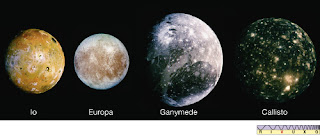As it was a Memorial Day weekend, the village was hustling and bustling with both locals and out-of-town visitors, with very few parking spaces available. In front of our space by the Esplanade, stood our guy from the Santa Cruz Astronomy Club, demonstrating to interested passersby live images captured by his gigantic telescope. I was ready to walk away, not totally impressed, thinking that I had seen it all before. Paul asked me to stop and have a new look into the telescope. To my true surprise, I saw our Moon accompanied not by Jupiter alone, but its four largest moons, Lo, Europa, Ganymede, and Callisto all neatly strung like jewels along the same orbital plane. Collectively they are called the Galilean moons.
Courtesy of https://en.wikipedia.org/wiki/Galilean_moons
That was the price for Galileo Galilei to speak the truth in 1610. What about now?



No comments:
Post a Comment